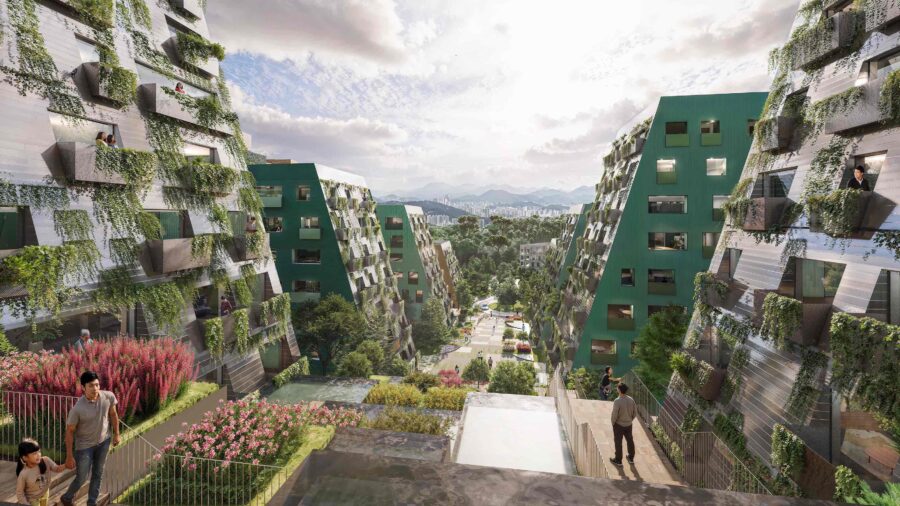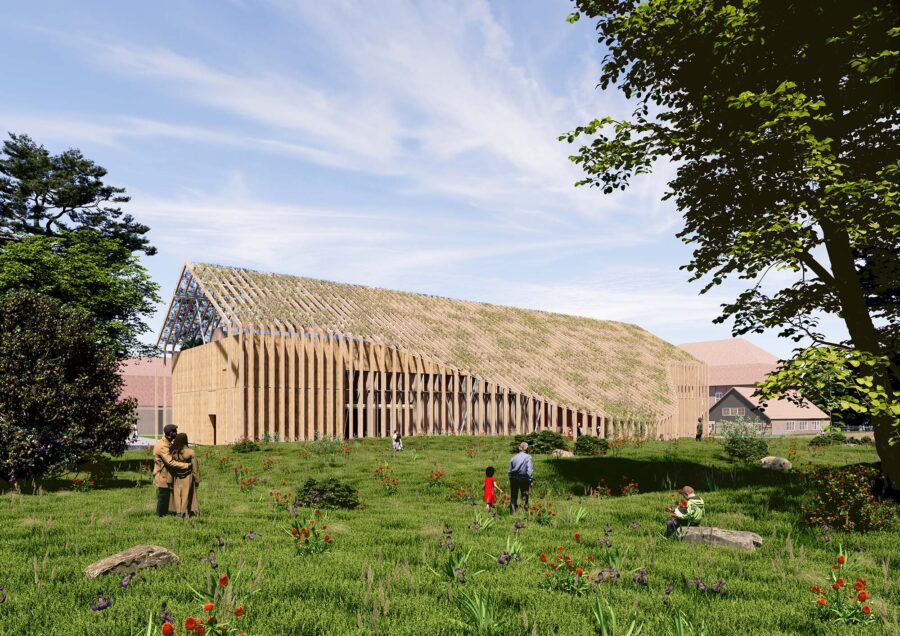
CULTURE


© SOM
〈グラス・ヴォールト(The Glass Vault)〉は、ガラスの圧縮強度とロボットの精密さを活かし、2本のロボットアームが相互に連携しガラスレンガを組み上げた、ヴォールト形状のインスタレーションです。
1936年の設立当初からさまざまな学際的なプロジェクトを手がけるSOM(Skidmore, Owings & Merrill)が設計した、海外でもさまざまな実践が進むデジタルファブリケーションの建築プロジェクトです。
(以下、SOMから提供されたプレスキットのテキストの抄訳)
©︎ SOM
デジタルファブリケーションには、建築のあり方を変え、持続可能なソリューションにつながる可能性が秘められている。
SOMはロンドンの展覧会にて、ガラスレンガ製のヴォールトをロボットが組み立てるという、高効率なエンジニアリングの新たな可能性を示すデモライブを行った。
©︎ SOM
コラボレーションによる新たな可能性
SOMは産業界や大学などのパートナーとともに、ロボットを使った新しい建築技術やアプリケーションの開発に取り組んでいる。
ロンドンで開催された展覧会「Anatomy of Structure: The Future of Art and Architecture」では、このコラボレーションの成果をいくつか紹介した。この展覧会の中心的な存在が、ガラスレンガのヴォールトを展覧会の期間中にギャラリー内でロボットが組み立てた〈グラス・ヴォールト〉である。

© SOM
SOMの構造エンジニアは、プリンストン大学のクリエイト・ラボとフォーム・ファインディング・ラボとともに、デルフト工科大学のガラス・透過性研究グループの協力のもと、このインスタレーションを開発した。ロボットアームはGlobal Robotsが、ガラスレンガはPoesia Glass Studioより提供されたものである。
チームはそれぞれの専門知識を結集し、ロボットアームが自立したヴォールトを組み立てるため、材料システム、構造設計、組み立ての各戦略を開発した。このインスタレーションの背後にある研究は、伝統的なヴォールトの建設方法を踏襲しつつ、高度なエンジニアリング技術を活用し、型枠やガイドなしで建設できる効率的で美しいシェル構造を作成するというものである。

© SOM
古くからある建築工法を21世紀へ
二重曲線のヴォールトのコンセプトは、構造理論に基づいた確かなものである。〈グラス・ヴォールト〉には、14世紀に開発された石造建築の一種である「ティンブレル・ヴォールト(timbrel vault) 」という形式を採用した。
この構造のヴォールトは地中海沿岸の至る所で見られ、ガウディやグアスタビーノを含む近代の建築家やエンジニアが世界中に知らしめた技術である。このインスタレーションは、ティンブレル・ヴォールトの技法を再考し、ロボットを活用することで、美しく印象的な構造デザインとなっている。

© SOM
SOMはマドリッドにあるアルカラ大学のティンブレル・ヴォールト・ワークショップ(Taller de Bóvedas Tabicadas)と共同で、この超軽量かつ高効率で強固なティンブル・ヴォールト構造を開発・建設した。このワークショップは、何世紀にもわたって受け継がれてきたティンブレル・ヴォールトという手法を、資源が乏しい地域で、安価に復活させることを目的として毎年開催されている。
〈グラス・ヴォールト〉は、型枠を使用せず垂直壁の上端からアーチをつくり出す、古くからあるバレル・ヴォールトの技術からヒントを得ている。ロボットによる施工ではまず中央のアーチを作成し、そこから何層ものアーチを連続させ、安定させるために左右のレンガをずらして配置している。

© SOM
ロボットと人間の協働プロジェクト
このインスタレーションは、ロボットによるデジタルファブリケーションが、より効率的で新しい建築手法を生み出すことを示している。
2本のロボットアームは、一方が構築中の不安定な構造を一時的に支え、もう一方が新たに素材を配置していく、といったように連動して動作する。ロボットアームの正確さと空間認識能力により、ガイドや型枠を使わずにガラスレンガを配置することができるのである。
このロボット技術によって人の手が不要になるわけではなく、むしろロボットと人間の密接な協力によって成り立っている。精度が要求される作業はロボットが行い、形状によって異なる部分の調整などは人間がリアルタイムで行っていく。

© SOM
SOMの構造・耐震エンジニアリングパートナーであるマーク・サーキシャン(Mark Sarkisian)は次のように語る。
「私たちは〈グラス・ヴォールト〉を、これからの建築のメタファーと捉えている。今日、非常に労働集約的である建設現場は、ロボティクスにより人間と機械が助け合って行くのかもしれない。」

© SOM
ガラスの建築
ガラスは高い圧縮強度という、ヴォールト構造に望ましい特性を持っているにもかかわらず、構造材料として採用されることはあまりない。
そこで、リサイクルが容易なガラスの構造的・意匠的な可能性を示すために、ガラスレンガを採用した。レンガはヘリンボーンパターンで配置され、レンガ同士のインターロッキング機構により、安定した構造となっている。
ガラスレンガの接合には、硬化が早く、剛性があり、建設中に各レンガを固定するのに十分な引張力をもつ素材が必要であった。また、レンガの形状による隙間の大小や、材料や構造の許容範囲の誤差への対応も必要であったため、速硬化性エポキシパテを選択した。

© SOM
ガラスは圧縮強度が高く、引張強度が低いため、ヴォールトの形状は引張力を最小にする必要があった。そこでデジタルモデリングによる検討により、最も効率的な構造体の形状を決定し、二重曲線を描く、圧縮のみがはたらくシェルとすることができた。
この形状は、ロボットの能力、特に空間認識能力と相互連携の可能性を示すために考案されたものである。形状はロボットの腕が届く範囲と、ロボットの移動に必要なクリアランスによって決定した。

© SOM
未来の可能性を示す建築
このガラスヴォールトのインスタレーションは、ロボットの能力と人間の創意工夫を組み合わせたさまざまな可能性を想像させる。
災害対策の分野では、ロボットによる迅速な避難所建設への応用の可能性があり、資源に乏しい地域では、伝統的な建築手法に立ち返ることで、耐久性が高く、低コストで建設できるソリューションとなる可能性がある。また地球に限らず、月、火星などの過酷な環境下でも、ロボットを使って同様の建築物を建設できる可能性がある。
そして、これらの手法は一般的な建設プロジェクトにも適用できる効率的な方法であり、大規模に適用することで、今回のガラスのような材料特性の引き出しや資材の効率化などの利点がより顕著となる可能性も秘めている。

© SOM
以下、SOMのリリース(英文)です。
Robotic Construction: The Glass Vault
Expertise: Structural Engineering
Topics: Advanced Fabrication, Applied Construction Technology, Partnerships, Robotics, Sustainability
Published: Oct 2021 – PresentDigital fabrication has the potential to transform the way that we build, and it may lead to sustainable solutions. For an exhibition in London, SOM designed a vault structure made from glass bricks and constructed by robots—a live demonstration of new possibilities in efficient engineering.
New possibilities through collaboration
Working with industry and university partners, SOM is developing new techniques and applications for construction aided by robots. “Anatomy of Structure: The Future of Art and Architecture,” at Ambika P3 Gallery in London, presented several results of this collaboration. The show’s dramatic centerpiece is a vault structure, built of glass bricks, that was assembled by robots in the gallery throughout the course of the exhibition.
Structural engineers at SOM developed the installation in collaboration with Princeton University CREATE Lab and Form Finding Lab, with assistance from the TU Delft Glass & Transparency Research Group. The robotic arms were provided by Global Robots and the glass bricks were provided by Poesia Glass Studio. Combining its expertise, the team developed a material system, structural design, and assembly strategy to enable robotic arms to assemble a self-supporting vault. The research behind this installation draws upon traditional vault construction methods while applying advanced engineering techniques to create an efficient and beautiful shell structure that can be built entirely without formwork or guides.
Bringing an ancient building method into the 21st century
The doubly curved vault concept has a solid foundation in structural theory. The structure created for exhibition is a type of timbrel vault, a masonry construction method first developed in the 14th century. Older structural vaults are found throughout the Mediterranean, and early modern architects and engineers including Gaudí and Guastavino made the technique known all over the world. The installation at Ambika Gallery revisits this construction technique, harnessing robotic capabilities to fabricate an aesthetically striking structural design.
The inspiration to build a glass-brick vault came from SOM’s ongoing collaboration with the Taller de Bóvedas Tabicadas (Timbrel Vault Workshop) at the University of Alcalá in Madrid, where teams of professors and students have been developing and building ultra-light, yet efficient and strong timbrel vault structures. The annual workshop seeks to revive this affordable, centuries-old construction method, which has particular value in places where resources are scarce.
The construction sequence for the glass vault was also inspired by an ancient barrel vault technique that allowed for construction without formwork, relying on inclined courses set against a vertical end wall. For the robotic construction, layers of arches are built off a central arch, and the bricks are staggered on either side for stability.
“We see the glass vault as a metaphor for construction in the future. We see it as a first step. Construction sites that typically today are very labor-intensive may be assisted by robotics in a collaboration between human beings and machines.”
Mark Sarkisian, Structural and Seismic Engineering Partner
Demonstrating the concept
The vault installation at Ambika Gallery shows how robotic fabrication methods can produce new and more efficient ways of building. The two robotic arms work in tandem: one serves as a temporary support while the other places the material. The accuracy and spatial awareness of the robotic arms allow them to place the glass bricks without the need for guides or formwork.
This robotic technique does not eliminate the need for human insight—in fact, the glass vault construction depends on close collaboration between robots and humans. The robots perform tasks that require precision and accuracy, while humans make real-time adjustments, such as applying the epoxy to gap sizes that vary due to geometry. As opposed to traditional construction methods for arches, which normally build from both supports upwards, the robots alternate placement and support to construct the arch from one end to the other without any scaffolding.
Building with glass
Glass is seldom employed as a structural material, even though its high compressive strength is a desirable property for vault structures. The team chose glass bricks to showcase the structural and aesthetic potential of this easily recyclable material. The bricks are laid in a herringbone pattern, which is inherently stable due to the interlocking mechanism it creates between the bricks.
The team studied various materials for the connection between the glass bricks: it needed to be fast-setting and rigid, with enough tensile capacity to hold each brick in place during construction. The material also needed to negotiate variations in the gap sizes between the bricks due to geometry, as well as material and construction tolerances. Ultimately, the team selected a fast-setting epoxy putty as the connection material.
Since glass has high compressive strength and low tensile strength, the geometry of the vault had to minimize any tensile forces. Digital modeling helped the design team determine the most efficient shape of the vault structure, which enabled the identification of a doubly-curved, compression-only shell.
The vault shape was also conceived to showcase robotic capabilities: in particular, spatial awareness and the potential for collaborative interaction. The shape was determined by the limit of reach of the robots’ arms, and the clearance required for their movement. Finally, the team planned the construction sequence to ensure the stability of the structure at every step.
Future possibilities
The glass vault installation allows us to imagine a range of possibilities that combine robotic capabilities with human ingenuity. In the realm of disaster response, the speed at which structures could be built with the aid of robotics opens up potential applications for rapidly constructed emergency shelters. In places where resources are scarce, a return to traditional building methods could offer a solution for durable, low-cost construction. Robots could even be deployed to construct similar structures in harsh environments, whether on the Earth, the Moon or Mars. And these methods provide efficient alternatives for more typical construction projects, where the benefits in how we use materials could be significant when applied at scale.
「Robotic Construction: The Glass Vault」SOM 公式サイト
https://www.som.com/research/robotic-construction-the-glass-vault/






![[大阪・関西万博]海外パビリオン紹介_ハンガリー](https://magazine-asset.tecture.jp/wpcms/wp-content/uploads/2025/07/03224519/rR0050410-900x596.jpg)


